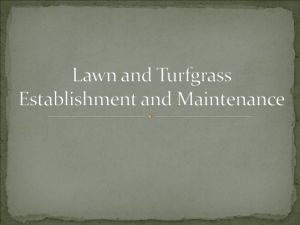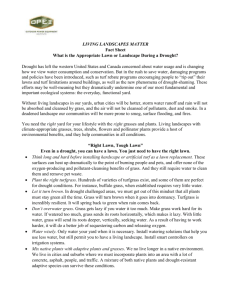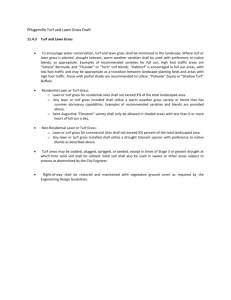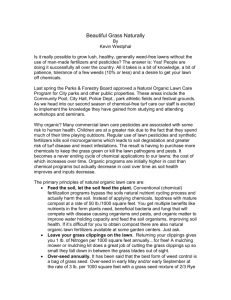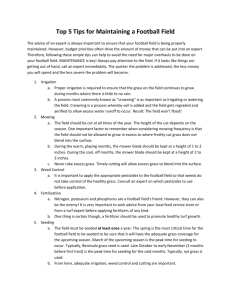A Romp Through The Grass - Boise Parks & Recreation
advertisement
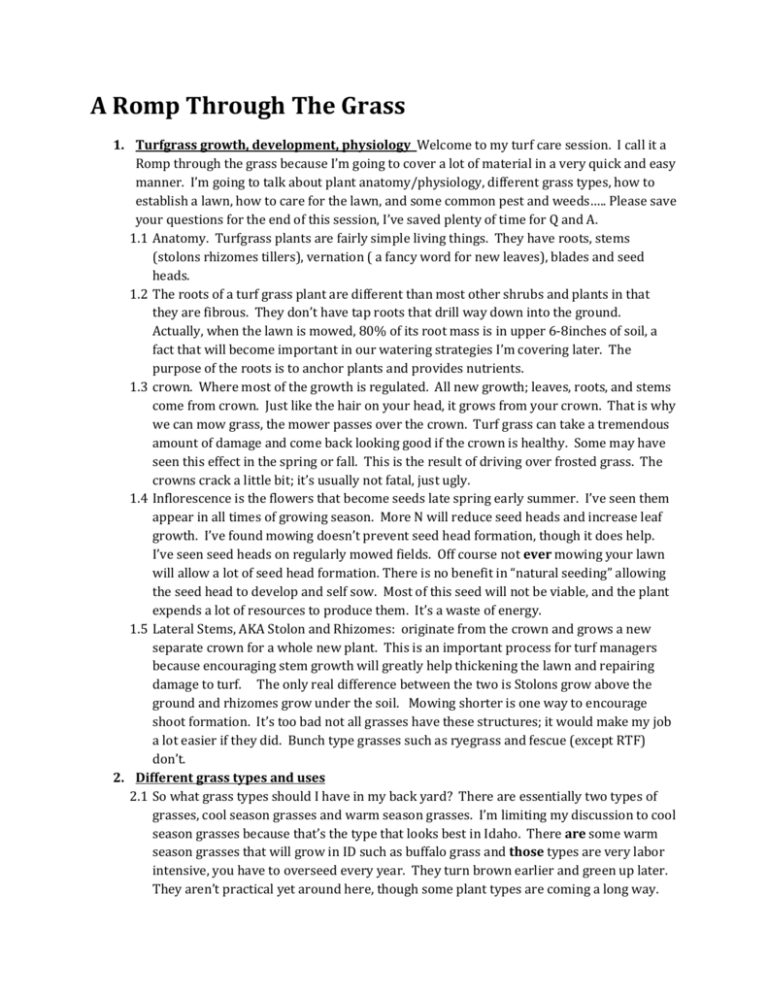
A Romp Through The Grass 1. Turfgrass growth, development, physiology Welcome to my turf care session. I call it a Romp through the grass because I’m going to cover a lot of material in a very quick and easy manner. I’m going to talk about plant anatomy/physiology, different grass types, how to establish a lawn, how to care for the lawn, and some common pest and weeds….. Please save your questions for the end of this session, I’ve saved plenty of time for Q and A. 1.1 Anatomy. Turfgrass plants are fairly simple living things. They have roots, stems (stolons rhizomes tillers), vernation ( a fancy word for new leaves), blades and seed heads. 1.2 The roots of a turf grass plant are different than most other shrubs and plants in that they are fibrous. They don’t have tap roots that drill way down into the ground. Actually, when the lawn is mowed, 80% of its root mass is in upper 6-8inches of soil, a fact that will become important in our watering strategies I’m covering later. The purpose of the roots is to anchor plants and provides nutrients. 1.3 crown. Where most of the growth is regulated. All new growth; leaves, roots, and stems come from crown. Just like the hair on your head, it grows from your crown. That is why we can mow grass, the mower passes over the crown. Turf grass can take a tremendous amount of damage and come back looking good if the crown is healthy. Some may have seen this effect in the spring or fall. This is the result of driving over frosted grass. The crowns crack a little bit; it’s usually not fatal, just ugly. 1.4 Inflorescence is the flowers that become seeds late spring early summer. I’ve seen them appear in all times of growing season. More N will reduce seed heads and increase leaf growth. I’ve found mowing doesn’t prevent seed head formation, though it does help. I’ve seen seed heads on regularly mowed fields. Off course not ever mowing your lawn will allow a lot of seed head formation. There is no benefit in “natural seeding” allowing the seed head to develop and self sow. Most of this seed will not be viable, and the plant expends a lot of resources to produce them. It’s a waste of energy. 1.5 Lateral Stems, AKA Stolon and Rhizomes: originate from the crown and grows a new separate crown for a whole new plant. This is an important process for turf managers because encouraging stem growth will greatly help thickening the lawn and repairing damage to turf. The only real difference between the two is Stolons grow above the ground and rhizomes grow under the soil. Mowing shorter is one way to encourage shoot formation. It’s too bad not all grasses have these structures; it would make my job a lot easier if they did. Bunch type grasses such as ryegrass and fescue (except RTF) don’t. 2. Different grass types and uses 2.1 So what grass types should I have in my back yard? There are essentially two types of grasses, cool season grasses and warm season grasses. I’m limiting my discussion to cool season grasses because that’s the type that looks best in Idaho. There are some warm season grasses that will grow in ID such as buffalo grass and those types are very labor intensive, you have to overseed every year. They turn brown earlier and green up later. They aren’t practical yet around here, though some plant types are coming a long way. This may be the future of turf care because of their ability to thrive in drought conditions. I’m only going to cover cool season. 2.2 All cool season grass has two growth bumps every year, one big one in spring, a slightly smaller one in fall that ends when the frost slows it down. These are the times when the plant is most vigorous, the speed of shoot growth is fastest and the depth of the roots is at their deepest and when seed heads are most likely to show up. Don’t worry too much about the seed head. Like I said, there isn’t much you can do about them anyway. I use this time to identify what I have. 2.3 I’ll go over the three most common cool season turf species. Tall Fescue, K. Bluegrass, Ryegrass, and Fine Fescue 2.3.1 Tall Fescue 2.3.1.1 Tall fescue tends to have broad, tough leaves. 2.3.1.2 If you want to know what you have, look to the young leaf (the vernation), is a great way to identify Fescue any time of the year. Look at the new leaves growing out of the crown down here, pluck it out and cut across it with a sharp knife. If it’s rolled up like a fist it’s probably Tall Fescue. Fisty Fescue 2.3.1.3 Tall Fescue is famous for its tough wear and drought tolerance. Fescue lawns look great. Several of our new parks have pure fescue lawns. They seem to need a little more Fe than other grasses and that’s not a big problem. The key downside with Fescue is it doesn’t recover well from damage, due to its bunch type nature. No rhizomes or stolons. You’ll need to overseed damaged Fescue lawns to get it to thicken back up. 2.3.2 Bluegrass: bluegrass on the hand recovers very well due to its awesome rhizome activity. It’s fairly drought tolerant and wears well too. These reasons are why it’s so popular in sports fields. On a highly maintained (highly funded) field you would cut Bluegrass to about 1.5 inches and give it a fairly high amount of fertilizer in multiple applications. We mow higher and only fertilize once and our lawns look pretty good, but more on mowing in a little bit. 2.3.2.1 pyramide seed head: These seed heads are very distinctive for me. You all have seen this I’m sure, the way they open up. Only Bluegrass does this. 2.3.2.2 Identify it just like I described earlier, cut the young leaves cross-wise and if they are folded, it’s probably K. Blue. This is how I remember: Kenny Rogers had a song “The Gambler” know when to fold ‘em”, Kenny Rogers is also a Fried Chicken Restaurant, and another fried chicken restaurant is Kentucky fried chicken. The connection is obvious, Kentucky knows when to Fold ‘em 2.3.3 Ryegrass 2.3.3.1 long spike seedhead, in the field they are more bunched together and look like spears. sometimes the various types will give a brownish look in lawn. It’s really annoying to my irrigators because from a distance the brownish look can be mistaken for too dry. It’s tempting to increase the water. Except it’s not too dry, they sometimes just turn a little brown and it can’t be helped. 2.3.3.2 The good thing about Ryegrass is its great wear and phenomenal germination rates. They’re tough little plants that can take a beating. It’s also resistant to bill bug. In fact its top notch disease resistance is the reason why it’s so commonly mixed with other seed types. Mixing in Rye will improve the fields overall disease resistance. Except for the seed head ryegrass looks a lot like K. Blue. 2.3.4 Mixed seed. I think the best lawns are made of a mixture of grass species. I like Blue/ Rye mixes (80%KB, 20%Rye) for the look, wear, recovery, moderate water use. Even better, in my opinion, are Blue/rye mixes that include fescue. About 40%PRye, 40% Fescue, 20% KB. You get the excellent wear tolerance of fescue, disease resistance of rye, recovery of KB. This is an overall superior mix. One note about grass mixes; don’t make your own, you may not like the results. It’s an art and a science. Finding species the will grow together and look good is hard. I’d probably end up with patches of grass going dormant sooner with off color pieces, dissimilar textures weaving about. Let the pros find the right types that look the same and grow well together. 3. Establishment There are a variety of ways to establish a new lawn. The two most popular ways, actually, the only two ways for the cool season grasses found around here are rolling and seeding. 3.1 It’s really nice to have that awesome lawn instantly by rolling out healthy sod. You’re less likely to have weed problems and the establishment time (the stay off the grass! time) is greatly reduced. Be sure to fertilize it and water it in after installation. Wait a couple weeks or so before mowing it, first gently pull on it to test its roots. You don’t want that beautiful new lawn wrapping itself around your mower blades. Best results are achieved when you prep the area beforehand. Cut out the old sod and level the area until its smooth. Roll the topsoil good and hard to prevent uneven settling. Then lay the sod. Water, roots, and time will break up the compaction. 3.2 The other way to establish a new lawn is by planting seed. It’s a lot cheaper and you have more control over what type of seed mix you use. Be sure to have good soil seed contact. That’s critical. The best time around here to sow seed is late summer, around aug or sept. The ground is warm enough to germinate the seed and the young seedlings get to grow in that second growth bump. You can also seed in the spring and your grass will probably need to compete with more weeds such as crabgrass and such that naturally germinate this time of year. Either way You need to keep it wet! . Now that we have a lawn, I want to talk about caring for it, aka cultivation. 4. Cultivation Now I’m going to talk about fertilization, mowing, watering, and aeration. First, fertilizer. Turf species need these elements to survive. 4.1 Fertilization mnemonic C HOPKINS CAFÉ MANAGED BY MY CUZIN MO the CLOWN. There you have it. All the nutrients your lawn needs. 4.1.1 The Carbon Hydrogen and Oxygen the plants get from the air. You need not concern yourselves with those. The rest come from the soil. I’m going to talk about NPK and Fe. 4.1.2 Macronutrients; NPK. Your lawn needs all three. These are the main ingredients in fertilizer. Those three numbers you see on a bag of fertilizer describe the amounts of NPK contained. First of the three is Nitrogen. N is continuously leaching through the soil and gassing off to atmosphere therefore we often need to supplement the soil with N. N is typically the limiting ingredient to growth and adding N will usually allow the grass to take off. It’s almost like magic, add a little N and BAM, the lawn grows crazy. This lawn could use a little of the N magic. The grass is yellow and won’t grow much, weeds invade especially clover. The grass next to the clover is green because the clover is supplying it with N. N is also the nutrient we need the most of. That doesn’t mean you always have to add N. Some areas don’t need annual N especially if you mulch the grass instead of bagging the clippings. You should pay attention to what the turf is doing, if it’s growing too fast and you’re mowing twice a week to keep up, why add fertilizer? It’s okay to skip a year. You could be over applying N. Don’t over N your grass. This is the most common mistake a lawn manager makes. It’s an easy one to make considering some of the spectacular effects adding a little N will produce. Problem is N stimulates shoot growth at the expense of root growth and carbohydrate storage. The roots become shallow and the leaves become too succulent. Perhaps you’ve seen a succulent lawn. It’s very fragile and soft. It doesn’t wear well at all. Succulent leaves cant handle environmental stresses. In addition, too much N will burn your lawn. . Our rule of thumb in the parks is to apply 1 lb N per 1,000 square feet annually. We’re using less P these days. In fact our chief fertilizer has no P, none whatsoever. P is especially important for root growth and they’ve found that P is a fairly stable nutrient in the soil. Once you have good P in the soil, there’s no reason to supplement it. P is a major pollutant to our water systems. Fertilizer without P is cheaper too! You may need to add supplemental P when establishing grass to help it develop roots. I’ve never seen deficient P in the field. There have been times when I’ve had to add phosphorus to young plants, but not grass. Likewise I’ve never seen deficient K. I guess the grass can be yellow and wilty. If you’re sure you have enough other nutrients, you’ve added N and Fe and the grass still isn’t living well, assuming there you haven’t sprayed with something deadly, suspect low K. We apply .5lb K /1,000 per year in the fall. You can always do a soil test at the local extension office on Glenwood. It’s highly recommended and we don’t bother. Except sometimes on new park sites. I won’t go into the other macros. 4.1.3 Micronutrients Mostly Fe. Fe is needed for production of chlorophyll. Fe dramatically affects the color. Deficient Fe turf looks yellow-green. It has a peaked look. PH makes a big difference in how affective the iron is. Having an alkali soil, which is common around Boise, will lock up Fe and make it unavailable to the plant. It’s possible to slowly change your soil’s pH by adding sulfur, it takes a few years, and it works though, if you’re patient. Be careful, you could burn your lawn, see me after class to go over how in more detail. Check your soil for fertility at the local county extension office on Glenview. 4.1.4 This is what our fertilizer strategy looks like. The solid line is N in the soil and the dotted line is the growth curve. We apply slow release fertilizer once in the fall (is most important time if you’re only doing once). When grass is storing carbs for winter. Our slow release doesn’t put enough N to stimulate excessive growth. A slow trickle of N applied in the fall will improve the lawns ability to green up in the following spring. If you’re using fast release fertilizer cut the rates down and plan to fertilize again a little in the spring. “Root growth is second to shoot growth. Be careful not to over stimulate shoot growth depleting the stored carbs” 4.2 Mowing 4.2.1 How you set the mowing height will depend on what you want to achieve with your lawn and your budget. Ideally you would mow shorter in the spring and fall to encourage stem growth-rhizomes and new leaves-to thicken the lawn and taller in summer to help shade and protect crowns and encourage root growth. Mow height affects root growth. The shorter the mow height the shallower the roots. In spring the roots will grow deep because the soil temperature is perfect, the grass is in a growth bump and it wants to grow deep, it will grow deep, you can afford to mow shorter. Don’t mow so short that you scalp the grass. But it is good to mow shorter-about 1.5”-in the spring and fall. This isn’t practical for us. It’s very expensive to adjust all our machines. We mow at 2.5 inches all year ‘round. This is a good compromise for us. (Tall fescue=1.5-3 Bluegrass 1-2.5 Rye 1=2.5 Fine Fes=1.0-2 ALL BENCH HIEGHT. Field conditions, uneven ground, thatch can affect actual mowing height.) If you mow too high-above 3 or 4 inches-the grass can become puffy and less uniform, also the crowns may elongate and the field may thatch up quicker. I tend to prefer a higher mowing height for my lawn. Mowing height also affects your mowing frequency. The lower the cut, the more frequent the mowing if you follow the 1/3 rule. 4.2.2 This is the 1/3 rule. Don’t cut off more than 1/3 of the leaf. For example if you’re cutting at 2.5”, you need to mow when the leaf is 3.75”. If you want .5” then you mow at .75”. This is why the golf course has to mow twice a day on the1/8” greens. The grass only has to grow a little bit before is should be mowed. It gets more expensive to maintain healthy grass the shorter you mow. Our mow height of 2.5” usually requires one cutting per week in the spring, sometimes a little less than that in the summer. Cutting off more than 1/3 of the leaf is a shock to the plant. If your lawn is too tall, say you’ve skipped a week or put off mowing ‘cause you went out fishin’, (..it’ll NEVER happen at my house I look forward to mow day!) If/when this happens it’s best to cut it once at a higher setting and then again a couple days later at your desired height. If you go ahead and mow it short in one step you may damage crowns, deplete the carbs and stress the grass unnecessarily, you’ll also have mounds of clippings to collect afterwards. Mowing too often or less than 1/3 is also hard on the turf, if you mow before it needs mowing, you’re wounding the grass for no reason=more susceptible to disease. Increased wear and compaction of the soil. It’s just a lot of unnecessary work. Keep blades sharp. Try to mow in different directions to spread out compaction and avoid scalping the same area over and over. 4.2.3 Consider mulching your lawn cuttings. Mulching does not promote thatch! Thatch is the layer of organic matter just below the grass line and above the soil. It’s composed of crowns and stems which do not decompose well, not cuttings. Leave decompose fairly quickly. We need to collect grass when there are piles of it. Grass piles interfere with games, they clump and kill grass. We always bag our clippings around the pools to keep the filters clean. Otherwise mulching your clippings is a very good idea. 2-3lbs of N per 1000’ can be removed if clippings are bagged all season. Also, mulching fallen leaves is also a good practice, we like to mulch leaves where we can. See how clean the lawn looks after a mower has chopped up all the leaves. 4.3 Irrigation 4.3.1 We live in a desert. We need to irrigate our lawns. Water deep and infrequent to encourage the development of a healthy root system. I said turf plants are simple, but doesn’t mean they’re dumb. If the top is always moist, why grow deep roots? The roots will stay in the top layer of the soil making them vulnerable to a drought or irrigation malfunction. 4.3.1.1 Give the lawn about 1/2 inch of water per occurrence. Why ½”? Because .5 inches is a solid, doable water event. Where grass grows naturally, without irrigation water, it will rain less often and heavier, sometimes about once per week or so dumping an inch or more at a time. .5 inch of water is a lot to deliver through sprinklers. Often in the hottest months of summer you'll need about 2” per week or four times. We have a weather station that gives us an accurate number for how much water is required on a daily basis. We feed this information into our irrigation controllers. You can go to Agrimet to get the same data for free. Fescue and Blue need about the same amount of water. In fact Fescue needs more but you can water less frequent and heavier with fescue because of the deeper roots. Fescue will also survive a drought better. Bluegrass will go dormant faster and recover faster. Having said that, regardless of the type of grass you have, it’s more important to focus on your affective root capacity zone, which is the top 3 inches to 6 inches. 80% of the root mass is up here. I don’t care deep the roots are, if the top 6” of your soil is dry, your grass is going to be brown. The long roots, down here, (gesture to bottom of the screen) are for surviving drought. They’ll sustain the crowns until the rain returns. The grass may be brown, but at least it’s alive…a good thing. Imagine your soil is a cup. You should water to the top of the cup each time you irrigate and allow the soil to dry to just before the wilting point. Watering this way will encourage your roots to grow deeper (which moves the bottom line lower) by allowing the top inch to dry between watering. Do not over water, or water past soil capacity. It’ll just run down the drains. It’s a waste. Recap: watering too often give you a green lawn with 80% of the roots too high, it’s vulnerable to a heat wavedeep and infrequent will push them down to 6-8”, you’ll have a green lawn and use less water. A lot less! 4.3.1.2 Depending on your soil and sprinklers you may need to cycle and soak your water. See different sprinklers vs different soil types. Example: shrub nozzles on sandy loam. Three cycles 5 and 5 to deliver .5 water. You can use a tin can method to determine precip rates. I need to learn test for infiltration rates. All depending on pressure, nozzle. Use a collection test. 5. Pest and diseases 5.1 Weeds 5.1.1 5.1.2 Weeds are usually the result of a weakened turf. Prevention is by far the best plan. Weak and thin turf is a result of disease, insect damage, overuse, drought or environmental conditions, shad, wrong mowing height-scalping or too tall, compaction. Good fertilization will help create a thick lawn. I’ll make a confession now. For a long time I didn’t know there was a difference between Crab grass and Quackgrass. I thought they were different names for the same thing. There is a difference. Probably in your established lawn you’re dealing with more Crab grass, especially on edges of your driveway or road. Crab grass requires light for germination which is way it tends to grow only where the lawn is thin. Use pre-emergent for these annual grasses. Premergents control weeds at the germination stage. Visible weeds are not controlled. The residue of preemergents will generally last in the soil for a few months so plan ahead if you plan to overseed. They’ll stop your new seeds! Quack grass will quickly grow in disturbed earth. It’ll rhizome and self sow. Only something like glyphosate will kill it. If you don’t like chemicals you could try repeated tilling, it may tire out and die, if you try this method it’s essential you keep up at it otherwise you’ll multiply the problem. 5.1.3 5.1.4 5.1.5 This is bentgrass. Bent grass has stolons-those shoots that grow above the soil to start a new plant- fine leaves, weird light green color, forms characteristic dense mats. Me and bentgrass do not get along. Once it gets started it slowly spreads year after year until it’s covering the whole lawn. It’ll make the lawn look patchy and uneven. When it gets hot, it’s the first thing to go dormant. You’ll need to apply a ton of water to keep it green. It may be great on the golf course, but in the lawn it’s awful. If you have this, just kill it and start over. In fact, bent grass is the only reason I ever put in a new lawn. I’ve tried a variety of cultural methods to control bentgrass without any success. I’ve heard Mesotrione ( Tenacity) is an effective pre and post herbicide for bentgrass, esp if applied in the late summer/fall. Warm springs is trying this out, we may be trying it in the fall. Everyone knows these guys, but did you know dandelion can produce 1,200 seeds in one plant! These are the three most common turf weeds; Thistle, dandelion, and clover, black medic shown here is also invasive. Of course the best control is prevention through maintaining a healthy lawn. But if you need to us herbicides this is my recommendation. Use Broad leaf selective herbicides: 2,4,D, Triclopyr/clopyrilide. Spray ‘em as soon as they appear and the weather allows. Later summer applications aren’t as effective. You could us Non selective herbicides such as Glyphosate, Diquat (Reward LS) and they will kill about everything, including your lawn. I guess that’s good if you want to establish a new lawn, but if you want to keep what you have any only kill the weeds…..use a selective. Always follow the label’s safety and application instructions! Don’t listen to me, I’m just a fella giving advice. The label is the law here in Idaho. It’ll also save you money by recommending the proper mixing rates. More isn’t necessary better. Be safe when handling and storing all pesticides. The most common way pesticide can harm you is through the skin. So wear gloves, wash your hands, and wear protective clothes. Safety glasses are usually suggested in most label instructions I’ve ever read. 5.2 Insects 5.2.1 Bill Bug, Little beetle with a snout ,aka proboscis. If you want to impress your friends use the word proboscis…”did it have a proboscis? If it didn’t have a proboscis it wasn’t bill bug because bill bug has a proboscis.” Most damage is caused by grubs; white, legless, with a brown or yellowish head. They chew the roots. A bill bug infestation looks like blotchy, drought stressed grass that doesn’t recover with more water. If you pull the stressed grass clumps of it will come out. Bill Bugs overwinter as adults, they lay their eggs in the stems in spring ( if you’re lucky you’ll see the adult crawling around on the sidewalk or hard surface, the eggs hatch and the larvae eat their way down through the crown and into the soil. The whole process only takes a couple months. In my experience, these punks return year after year in the same areas. Therefor if you see this (the damaged lawn) I recommend you make a note of the area so you’ll remember later in the spring, go ahead and treat it right away with some form of insecticide, we use imidiclopyrilde… read the label ect…,repair the damage by overseeding and applying a little fertilizer. Be sure it has some P and K for the root repair. In the following spring, get out your notes and preemptive strike these guys before they show new damage. Spring application is most affective because you’re killing adults who are laying eggs and the residuals will kill the vulnerable little devils when they hatch. Different Billbug species have different life cycles, times of year when they hatch. I usually shoot for some time in May (gesture middle bottom at May). You can contact local UI County Extension office such as is located on Glenview. 5.3 These rings are gateways to the Elvin Kingdom! Don’t mess with them. Some people like these rings. And why not? They don’t really hurt anything. Fairy rings are caused by a harmless fungus that likes low fertility soil and low moisture. Thatchy turf is also a little more prone because there’s more decaying matter and places for it to grow. I personally don’t care for them so I give fairy ring a little extra N to mask the effect and a little extra water to drive them away. If you have a mushroom situation in your yard and it’s unacceptable because you’re afraid the kids may eat them or you can’t stand the look of them. Adjust your fertilizer (a little more N can help speed decomposition) and lower the irrigation some. Picking them as soon as they come up doesn’t help much. ‘Shrooms can live a very long time, spores are in the air and can travel long distances. Spraying them won’t do you much good because most of this animal exists below ground. If you can wait they often will go away on their own after they’re done munching on whatever it is that’s decaying under the soil. The good news is they are not that harmful to the lawn. If you really really can’t stand them the only way to get rid of them is to dig up a the soil down to about 6 inches. Look for stumps or rotting mats. Someone once found plywood, he had a newer house, the construction crew buried the extra scraps of lumber. Take out anything that may be feeding them and replace with new topsoil. 6. Benefits of turf 6.1 Aesthetics. Most of us are here because we like turf. We like how it looks in our landscape and we want to take care of it. A green growing lawn can soften the landscape. A well cared for lawn is pleasant to look at. There are several other reasons for planting a lawn besides it looking awesome. 6.2 Healthy soil. Turf plants create very healthy soil through the creation of humus through decomposition roots and shoots. Mulching your clippings will add even more. Maintaining turf will increase the fertility of the soil. 6.3 cooling. Esp on sports fields playing Frisbee or a catch I the park. When the temperature of a sidewalk is 100degrees the turf next to it will be a consistent 75 degrees. A study at Texas AnM University showed that grass will lower temperature 3040 compared to bare earth. The evaporative cooling of grass dissipates about 50% of accumulated solar heat. Eight average lawns produce the cooling effect of about 70 tons of air conditioning. 6.4 Air improvement 6.4.1 6.4.2 A healthy turf can absorb hundreds of pounds of sulfur dioxide. Carbon capture. Grass needs CO2 to grow and live. It takes the CO2 it needs from the air. 6.4.3 Creates oxygen. In photosynthesis the CO2 turns into O2 for us. An area 50 by 50 can generate enough O to meet the needs of a family of four for a single day. It’s been estimated that the grass and trees along the US interstate highways produce enough O to support 22mil people. 6.5 water capture and filtration 6.5.1 Erosion control. The roots help stabilize the soil, shoots slow down the runoff so less water goes into storm drains. More water goes into the ground water recharge. Slower run off also means less pollution goes into the storm drains that empty into the Boise River. The turf traps those pollutants. 6.5.2 Roots act like filters that clean the water as it goes into underground aquifers. 6.5.3 Xeriscape is great if you know how to irrigate it. Studies have shown that most of those xeriscaped landscaping in Arizona and New Mexico use more water than a lawn. They should us less if the owners knew how to water the plants, what this tells me is that people waste water, not grass. 6.6 Reduces noise. Turf acts like an acoustic screen and sound deadener. It absorbs noise better than a heavy carpet on a felt pad according to one study. 6.7 Fire prevention. Green grass is a defensible space around your house. 6.8 Glare reduction. Turf will help lower the glare along roadways. It doesn’t bounce the light back to the drivers making driving more comfortable.

